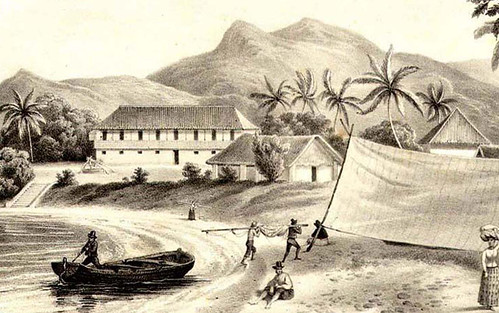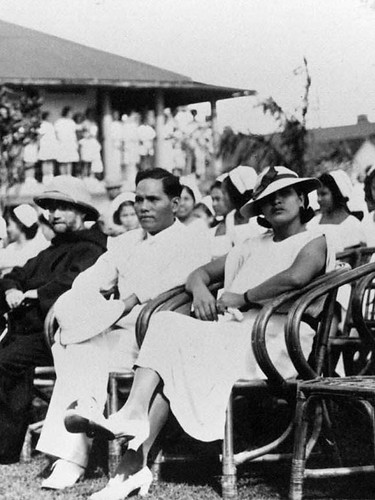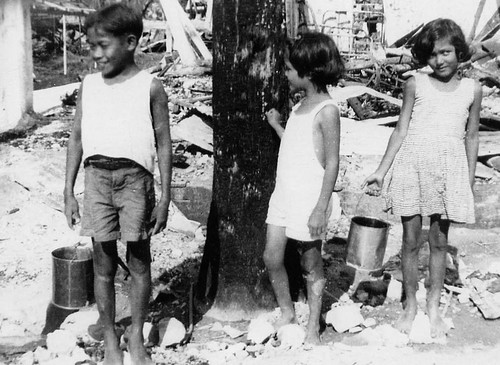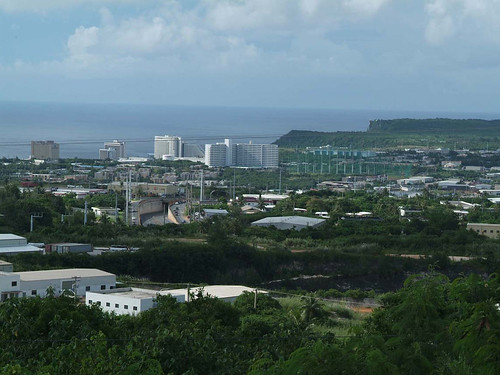Guampedia view
People first arrived on Guam and the rest of the Mariana Islands probably from Southeast Asia, possibly in many waves over many years. These people evolved into the CHamoru / Chamorro people with their own distinct language and way of life.
With the establishment of the first Catholic mission, Guam became a colony of Spain until the Spanish-American War of 1898. The CHamoru people adapted to a new way of life that mixed traditional beliefs and customs with Christianity and other foreign influences.
The US Navy ruled Guam from 1898 until the Japanese invasion in December 1941. The navy built up Guam’s infrastructure and introduced American culture. Despite the limitations on CHamoru rights, the CHamorus petitioned for US citizenship several times, as early as 1901.
1941 – 1944: World War II/Japanese Era
Japanese imperial forces occupied Guam from 10 December 1941 to 10 August 1944. Life under Japanese rule was harsh, but the CHamoru people endured, guided by strong religious faith and a sense of loyalty to the United States.
A period of rebuilding after the destruction of World War II. The US military took control of government and large tracts of land for military bases and recreation. The people of Guam pushed hard for self-rule and US citizenship.
The Organic Act of 1950 granted CHamorus US citizenship but only limited self-government. The US president appointed civilian governors. The Organic Act set up the Government of Guam’s administrative structure, the Legislature and the Courts. The term “Guamanian” was coined, referring to CHamorus and others for whom Guam is home.
1970 – Present: Contemporary Guam
Guam’s first elected governor took office and the island experienced economic growth and urban development. Tourism became a viable industry alongside the military presence. CHamorus continue their struggle for self-determination, cultural preservation, and to meet the challenges of a global world.
Overview of Guam’s History
Guam, the largest and southernmost of the Mariana Islands chain, has a unique and complex cultural history. Located in the Western Pacific in the geographic region known as Micronesia, Guam is well known for its strategic military and economic position between Asia and the North American continent but is less known for its remarkable history and resilient people.
Inhabited for thousands of years, the Marianas are home to one of the oldest Pacific Island cultures. Archaeological evidence indicates that the Marianas Islands were one of the first places to be settled by seafaring peoples, possibly from Island Southeast Asia, over 4000 years ago. Although it is uncertain whether the islands were settled in waves of migration or all at once, the Mariana Islands appear to have been continuously occupied by people who shared the same culture and language that eventually became known as CHamorus.
Guam not only has a unique ancient history, but a complex colonial history as well. Guam is the site of the first Roman Catholic mission and formal European colony in the Pacific islands. In fact, the last 400 years of Guam’s history are marked by administrations of three different colonial powers: Spain, the United States and Japan.
With each administration, came new challenges and changes for the CHamoru people. As a Spanish colony, the CHamoru people adapted to influences regarding religion, social organization and cultural practices from Spain, Mexico and the Philippines.
The ceding of Guam to the United States as an unincorporated territory after the Spanish-American War in 1898 introduced CHamorus to democratic principles of government and the modern American lifestyle, while keeping them subjects of a sometimes oppressive US naval administration.
Guam also had a unique position in World War II, when Japan invaded the island shortly after the attack on Pearl Harbor in December 1941. For the next three years, Guam was occupied by Japanese forces, and the CHamorus were thrown into a war not of their making, until the Americans returned in 1944 to reclaim the island.
The political maneuverings after World War II and the post war buildup led to even more expansion of US military interests in Guam and the rest of Micronesia, with Guam becoming a hub for economic and commercial development. The easing of military restrictions for entering Guam and the establishment of a local, civilian government, have made the island an ideal place for people from all over the world to visit, go to school, find jobs or pursue a variety of economic interests.
The different eras of Guam’s history are highlighted with moments of resilience, strength, adaptation and innovation as the CHamoru people have found ways to adapt to the challenges of cultural and historical change. Today, Guam has a diverse population that enjoys a rich, multicultural, modern and urban lifestyle, but in its heart endures the spirit, language and culture of the indigenous CHamoru people, for whom Guam has always been “home.”






